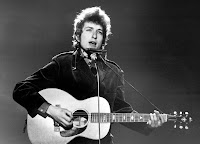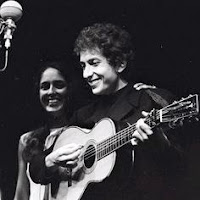“Johnny's in the basement,
Mixing up the medicine
I'm on the pavement,
Thinking about the government
The man in the trench coat,
Badge out, laid off
Says he's got a bad cough,
Wants to get it paid off…”
Maybe if I wrote lyrics like that I would have won a Noble prize? Bob Dylan did!
 |
| Bob Dylan - Susie Rotolo on the cover |
In the mid 1960’s Bob Dylan wrote many wonderful songs with poetic lyrics which were sometimes very bizarre. Some of his music and some of the lyrics were taken from older folk songs. No worries, as those songs were public domain at the time. But most of Bob's songs were pure genius.
 |
| Bob Dylan - Albert Grossman |
When manager/impresario Albert Grossman took him on as a client, it seemed like Dylan became famous overnight.
 |
| '63 Dylan -Washburn - North Country Blues |
I've been a Dylan fan since I was a kid in the mid 1960's, so I thought it would be interesting to take a look at the guitars that Bob Dylan has used throughout his career.
 |
| Bob Dylan in High School with Stella guitar |
 |
| Dylan's Silvertone |
The next guitar he is said to have owned was a Silvertone Aristocrat 642 Archtop. He played this in a high school talent show. It is currently on display at the Hibbing, Minnesota public library.
 |
| Dylan with '49 - 00-17 |
Dylan's first decent guitar was a 1949 Martin 00-17 all mahogany guitar. He was probably inspired by his hero and mentor Woody Guthrie. Guthrie played "00" and small bodied guitars. In pictures and videos of his early concerts Dylan is usually seen playing a small body guitar. This one look like it has been through the mill.
 |
| Dylan with Gretsch Rancher |
When he was a young man, Bob also made use of a 1950's Gretsch Ranger.
 |
| Bob with Washburn 5250 |
In 1963 Dylan showed up at the Newport Folk Festival with a Washburn model 5250. This guitar had a slightly arched top, with a round sound-hole. The strings went over a wooden bridge, that was held in place by the strings. Then the strings were secured to a trapeze tailpiece.
 |
| Dylan with Washburn Tanglewood guitar |
 |
| Dylan with 1950's Gibson J-50N |
His next guitar was a late 1940’s Gibson J-50N. It must have been a model made after WWII because it does not have the Only A Gibson Is Good Enough banner. This guitar had a teardrop pickguard and is featured on the cover of “Bob Dylan”. This guitar was lost or stolen.
 |
| Dylan with Gibson Nick Lucas Special |
The original Nick Lucas models from that era had trapeze tailpieces. Later models featured the belly bridge.
 |
| Bob's Gibson LG-1 |
In 2006 a photographer was touring Gibson's Montana facilities when he spied two Gibson LG-1 with tags that had Dylan's name on them. Bob had ordered the custom shop to build them, perhaps because he was so fond of the Nick Lucas guitar, which by the way was based on the LG-1 body with a 13 fret neck.
 |
| Dylan -Baez - Martin 0-45 |
Dylan borrowed a Martin 0-45 from Joan Baez, who he was dating at the time for a performance at the 1964 Newport Folk Festival.
 |
| Dylan with Gibson J-200 |
Dylan also owned several Gibson J-200 guitars that were played in concert. One was a gift from George Harrison. One was custom made by Gibson and it had a double pickguard.
 |
| Dylan with Martin 0-18 |
Bob Dylan was also fond of Martin 0-18’s and 000-18’s and can be seen playing both. In a 1974 concert to benefit the nation of Chile; a country in the midst of a revolution at the time.
 |
| Dylan with Martin 00-21 |
Dylan owned and is photographed here with a Martin 00-21. During the 1960's,
 |
| Dylan at '65 Newport Folk Festival |
Folk singer Pete Seeger became so angry it is said that he wanted to cut the electric lines going to the stage. (Other accounts say, that he was just yelling, "Cut, cut" in an effort to make Bob and The Band to stop playing.)
 |
| With a '60's Strat and Ampeg amp |
Some black and white photos from the session at the Colombia recording studio A, show Bob playing the Strat.
 |
| Fender Jazz Bass - Bandmaster - Jaguar |
Possibly from the same photo shoot we also see him with a 1960's Fender Jazz bass, and a 1962 Fender Jaguar.
 |
| Dylan playing a Fender XII |
In a poster for the Bootleg Series Volume XII, we see Bob playing a Fender XII.
 |
| '65 Fender Jazzmaster |
In another publicity photo Dylan is seen with a 1965 Fender Jazzmaster.
 |
| John Sebastian - Bob Dylan - ? Bass |
 |
| Playing a Fender Kingman |
 |
| Martin OM-28 |
He also received a special Martin guitar through his guitar tech, Cesar Diaz. This was a Martin OM-28 Perry Bechtel model. Bechtel was an entertainer in the 1930's and requested that Martin create the OM style guitar with the neck joining the body at the 14th fret. Note the pyramid bridge.
 |
| Dylan with Martin D-28 |
Dylan also played a Martin D-28 at the Concert for Bangladesh and a HD-28 in the Rolling Thunder Revue.
 |
| Yamaha L-6 |
Bob utilized a Yamaha L-6 for the Budokan Tour.
 |
| Dylan with Yamaha L-51 |
This guitar had an unusually shaped headstock.
Then later on he used a black Yamaha L-52.
 |
| Dylan with Yamaha L-52 |
The L-6 is a low end Yamaha, while the L-51 is a solid wood guitar with an unusual rippled headstock. The L-52 model has a jumbo body, like a Gibson J-200, only with squared off upper and lower pickguards and a bridge similar to a Gibson Dove. This was a nice guitar, with cloud inlays on the ebony fretboard. Yamaha offered this model around 1972. Paul Simon also used a similar guitar.
 |
| 2001 Negative Martin |
Bob must have liked the look of the black Yamaha L-52, since around 2002 Martin came out with a Negative HD-28, which had a black body and a white neck and headstock. Dylan had one commissioned with twin white pickguards and used it in a 2002 concert.
 |
| Dylan with Stratocaster |
For as much trouble as the electric guitar caused for Dylan, he did not play it in concert as much as his acoustic guitars. His best known electric guitar would be the 1960’s sunburst Stratocaster that he played at the Newport Folk Festival in 1965, when he got booed while playing “Like A Rolling Stone”.
 |
| The Strat that Dylan used in 1965 |
It was also featured in some early pictures of him in a recording studio. He only used it a few times and then it went missing.
 |
| 1965 Dylan with Telecaster |
Dylan also played several Telecasters starting in 1965 with a sunburst model with his band called The Hawks.
 |
| Tele used with The Band |
One of the more interesting guitars that Dylan is said to have played, but not owned, was Mike Bloomfield's 1963 Fender Telecaster.
 |
| Bloomfield's Tele - before and after |
Bloomfield also recording those guitar licks on Highway 61 Revisited with this guitar and Dylan is said to have borrowed it during the recording sessions.
 |
| Bob with Kramer Ferrington bass |
While in the Traveling Wilburys, Dylan sported this 1987 Kramer Ferrington bass guitar.
 |
| The Traveling Wilburys |
He is also seen with the Wilburys posing with this Gretsch Silver Jet.
 |
| Dylan with Gibson Hummingbird |
Around 1993 Dylan played a Gibson Hummingbird guitar in concert.
 |
| With a Gibson Black Dove |
A year later Bob was using a Gibson Dove.
 |
| Dylan with Gibson J-45 |
Dylan also owned a Gibson J-45 with twin pickguards.
 |
| 2016 Nobel Prize |
In 2016 Bob Dylan was honored as the recipient of the Nobel Peace Prize in literature.
Click on the links in the photographs for their source. Click on the links in the text for further information.
©UniqueGuitar Publications (text only)





















